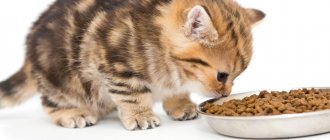Home » Useful Information
Weight gain during the period of active growth of a kitten plays a big role. Monitoring this indicator is important so that deviations can be noticed in time and the causes that caused them can be eliminated. To make it easier to keep weight characteristics under control, you can use special tables.
- 2 Why do you need to monitor a kitten’s weight at different periods of its growth?
2.1 What is a weight diary
- 3.1 Video: how to weigh a cat
- 4.1 Table: average body weight of kittens in the first 6 months of life
How does a kitten's weight change as it gets older?
If babies are healthy, they will gain weight daily. A day after birth (second weighing), the weight of newborns, if they are not sick, will increase by at least 8-10 g. The strongest kittens gain 14 g in weight by the second day of life. If a baby whose weight at birth corresponded to the norm, during the second day of life he did not gain at least 7 g, this should alert the breeder.
A newborn baby should weigh up to 170 g
During the first week of life, a newborn's weight may double.
Important! The kitten, who lived for 10 days and gained 168-174 g, has passed the first critical milestone. The majority of newborns die during this period. Almost always the cause of death is a lack of mother's milk.
Kittens are fed around the clock at intervals of two hours. When eating, the kitten should lie on its stomach. It is unacceptable to feed your baby adult food, such as cow's or goat's milk. This can cause diarrhea and, as a result, weight loss and death. The breeder must also weigh the kittens daily and record the results.
Comparison weight of adult cats of different breeds
Kittens experience explosive growth during their first 12 weeks. This growth should be obvious, which is important for the nursing cat and also for us, their owners. The cat provides her kittens with an excellent feeding regimen, grooms and nurtures them, helps them grow and learn. And if the kitten does not have a nursing cat, then people have to do it.
However, sometimes problems arise in both scenarios. And it is important to identify these problems as early as possible, since the ability to grow and develop is vital for a helpless kitten.
How much should a cat weigh at different stages?
Chihuahua weight by month and week: table
During the first 15–20 days of life, kittens spend most of their time sleeping. After about 16 days from the moment of birth, babies begin to be interested in the events happening around them, frolic and play.
The table shows the weight of a growing kitten by month:
| Kitten age | Kitten weight by month | Note |
| 1st day of life | Approximately 99 g | Average weight of a newborn kitten |
| 7th day of life | 149 g | If a 7-day-old kitten weighs less than 99 g, he is either seriously ill or malnourished. |
| 14th day of life (0.5 months) | 170 g | The weight of a kitten is given, which is not sick with serious illnesses, but also does not receive the maximum portion of attention. |
| 21 days of life (0.7 months) | 225 g | With special care, kittens reach the specified weight at the age of 14 days |
| 35th day of life (1.2 months) | 450 g | The weight of an absolutely healthy, naturally strong kitten is indicated. |
| 2 months from the date of birth | 900 g | The cat no longer feeds her kittens; their future fate depends entirely on the owner. The permissible minimum weight at this age is 710 g |
| 3 months | 1400 g | The average weight of a typical kitten is indicated. |
| 4 months | 1800 g | Average weight |
| 5 months | 2300 - 2900 g | Male kittens weigh more than their sisters |
The table shows the average weight. The exact indicators depend on the breed, gender and health status of the kitten.
Outbred kittens develop in approximately the same way as purebred kittens, only their mortality rate is higher due to the lack of additional nutrition.
A weak kitten weighs very little from the first days of life
Note! An animal that at the time of birth weighed less than its littermates will not be able to do without additional nutrition. Pushed away from his mother's nipples by stronger brothers and sisters, he does not receive enough nutrition, does not gain weight and becomes weaker.
Kittens stop needing mother's milk within a month after birth. By this time, their fangs and incisors have erupted, their ears take a vertical position (in representatives of straight-eared breeds), and their weight reaches 440-470 g. A kitten that has reached six months of age is considered an adult and weighs about 3 kg.
The norm is 4-5 months
At this age, the average weight of a kitten is 1.5-3 kg. The period of intensive growth has ended, but the pet still continues to gain weight. At the end of the 5th month, males can reach 4 kg.
Your pet still needs to eat baby food frequently. The number of feedings is up to 5 times. Diets should be chosen with the maximum protein content, which is necessary for the normal development of the growing predator’s body. Industrially produced food is marked with the appropriate inscription “For kittens”. However, it is necessary to carefully study the composition in order to choose a quality nutrition.
Rules for weighing kittens
German Shepherd weight by month: table
Kittens must be weighed every day. If they look healthy, once is enough. Sick newborns, as well as those whose weight at birth was less than 80 g, are weighed twice a day. The weakest and most disease-prone babies are usually born in large litters (5 or more kittens).
Important! Experts recommend weighing them at the same time to get the best idea of newborns' rate of weight gain. Without this, the breeder will not be able to determine the amount of additional nutrition. Overfeeding kittens is no less difficult than underfeeding.
During the weighing session, the mother cat must be kept near the kittens so that she can see what is happening with her children. Excessive worry can negatively affect the quality of mother's milk. To create the most accurate picture of kittens growing up, experts advise:
- Mark identical kittens with different colored food dyes. This will make it easier to identify them. The tags will have to be periodically updated, since the cat, licking the babies, will wash them off;
- use electronic kitchen scales as the most accurate;
- record weighing results.
Exceeding the norm
In a city apartment, cats are most at risk of obesity, and if you add unhealthy diet to this, then problems with excess weight will not take long to appear.
An overweight cat has no waist at all, and its belly protrudes in both directions. Observe your cat, if it is difficult for her to lick herself and raise her paws, then there is a reason for this.
Take the cat in your arms and try to feel the ribs; they should be easily palpable, but not protruding. In the case of obesity, it will be problematic to feel the ribs, since they are covered with a layer of fat.
In most cases, obesity problems in pets can be controlled by adjustments in the diet, but sometimes obesity can be a symptom of other diseases, so it is better to seek advice from a veterinarian.
What does weight depend on?
Yorkie weight by month: table, standard, how many months it takes to grow
Male kittens weigh more than females as they grow up. With each new weighing, the difference increases. The weight of mature males and females is influenced by a number of factors.
Bengal cats
During the first week of life, the weight of a Bengal kitten can reach 250 g, and after another three weeks the baby will weigh from 400 to 500 g. A three-month-old teenager weighs about a kilogram.
A Bengal kitten reaches 1 kg at 3 months
Bengals are a fairly heavy breed, but they are never fat. Kittens are very active and energetic, they run a lot, they are always in excellent physical shape, although they look well-fed and even overfed. They owe their appearance to their natural muscularity.
Note! The weight of a Bengal kitten depends to the greatest extent on the development of its muscular system. We must not forget that Bengals are big-boned animals.
"British"
On the 7-8th day of life, 70-gram babies already weigh 110-150 g. When they are two weeks old, their weight will increase to 210-420 g. The specific weight depends on gender, health status and the number of kittens in the litter.
Scottish Fold
If at birth cats of this breed weigh 70-120 g, then after two weeks these figures increase to 440 g. A two-month-old “Scottish” kitten weighs about 800 g. After another month and a half, its weight will increase to 1.5 kg.
Representatives of this breed, even when they grow up, do not cease to look like teddy bears with a rounded head on a short neck and large, widely spaced round eyes. Males that have reached puberty weigh from 4 to 6 kg, and females - from 2.7 to 4 kg.
“Scots” are usually good-natured and calm. They love to be outdoors and never miss an opportunity to participate in outdoor games. Loneliness and a sedentary lifestyle make them depressed and, as a result, lead to obesity.
Siberian cats
Siberian cat kittens are born weighing 60-130 g. Girls and the weakest newborns weigh less, boys, as well as kittens born at the beginning of the litter, have the greatest weight. During the first month of life, their weight increases by 12-15 g daily.
Sphinxes
Representatives of this species require high-calorie food to avoid hypothermia. The weight of females that have reached the age of 8-9 months can reach 3-4 kg. Males weigh from 4 to 5 kg.
The Sphynx needs to be fed a special diet
Sphynx kittens are not separated from their mother until they are one month old. During this period they feed on her milk.
Thai cats
The weight of a 3-month-old male can reach 1.8 kg. A female at this age weighs about one and a half kilograms. When the kittens are six months old, the male will weigh approximately 2.9 kg and the female 2.3 kg.
Why do you need to monitor a kitten’s weight at different periods of its growth?
A kitten's weight is a very important aspect of its development. The baby's weight needs to be monitored for several reasons. For example, by the age of one month, a kitten can weigh up to 500 grams. If his weight differs from this indicator in the direction of decrease, this may be caused by the following reasons:
- diseases, congenital or acquired;
- numerous litters;
- the mother’s lack of a complete diet that can provide nutrition for both the cat herself and her babies.
During the feeding period, the cat's food volume should be increased by 30% of the normal daily intake.
An underweight kitten may indicate that the baby is malnourished. He becomes lethargic, sleeps a lot, and apart from the general mass of kittens. In this case, you need to increase the amount of food for the nursing cat and monitor how long the weak baby stays at her breast.
Once I brought foundlings to my nursing cat. They were left without a mother, and besides, unkind people simply abandoned them to their fate. The two babies quickly got used to it, actively sucked the cat and did not differ from her “native” kittens. One kitten was very weak, he could not defend his place at the nipple and was often left out of work. Sometimes he still managed to get comfortable, but he quickly got tired and soon fell asleep without having eaten enough. Since I closely followed the adaptation of foundlings, I immediately noticed this (literally within 24 hours). The baby had to be fed separately. I gave him a special mixture, but also tried to get him to latch on to the cat’s breast more often (the more lively brothers had to be pushed aside for a while). As a result, this baby still lagged behind the others in weight, but caught up with them in height by about a year.
If a kitten is diagnosed with any disease, then to correctly calculate the medicinal suspension you will also need to know the exact weight of the animal. Therefore, a conscientious owner always monitors this indicator.
What is a weight diary
Every caring owner should keep a kitten's weight diary. This must be done regardless of whether the kitten grows up alone or with its mother cat and brothers. It is necessary to record all weight indicators in the diary, which can later help track whether the baby is developing normally.
The weight diary can be kept in any form, as convenient for the owner. This is an ordinary notebook for me. In it I write down the date of birth of the kittens, the names I gave them, as well as everything related to caring for them. This is not only their weight, but also the dates of treatment for fleas and worms, as well as the dosage of drugs (which, by the way, depends on weight). This is very convenient because over time I forget when, for example, I processed animals. A hint notebook helps me remember, especially since I now have 4 cats and a dog, so it’s quite possible to forget or confuse something.
How to prevent obesity in kittens
The change in nutrition plan is carried out gradually. Experts advise extending the transition to a diet for 7-14 days. If the kitten does not receive its usual food for 3 days, and the new food is not to its taste, the period of forced fasting may affect the functioning of the liver. The best way to transfer an animal to a new food system is to gradually, in small portions, replace the usual food with dietary food.
Important! To prevent the kitten from overeating, portions must be dosed, and feeding should be done strictly according to the clock. If food is constantly at the animal’s disposal, it will be difficult for the owner to keep track of exactly how much the baby eats and at what time.
After filling the bowl with food, leave it for about 20 minutes and then remove it until the next meal. If the cat has already reached adulthood, it is recommended to give food 3-4 times a day during the first week, and 2-3 times a day during the second week. Ultimately, the daily dose is divided into 2 doses.
Portion sizes depend on the type of food and calorie content. The animal should receive the recommended daily dose corresponding to its weight (indicated on the package).
Detailed schedule
A detailed chart of weight gain in domestic cats is as follows:
- newborn babies: females – 116–145, males – 118–147 g;
- 1 week: 240–260, 240–280 g;
- 2 weeks: 340–400, 350–420 g;
- 4 weeks: 560–740, 630–820 g;
- 6–8 weeks: 1.15–1.4, 1.2–1.5 kg;
- 10–12 weeks: 1.7–2.3, 1.8–2.3 kg;
- 14–16 weeks: 2.6–3.6, 2.7–3.8 kg;
- 5 months: 2.9–4.3, 3.2–5.5 kg;
- 6 months: 3.2–4.5, 3.9–6 kg;
- 7 months: 3.5–4.9, 4.2–6.5 kg;
- 8 months: 3.8–5.2, 4.5–6.9 kg;
- 9 months: 4.1–5.5, 5–7 kg;
- 10 months: 4.2–5.8, 5.3–7.7 kg;
- 11 months: 4.3–6.1, 5.6–8 kg;
- 1 year: 4.5–6.8, 5.7–9 kg.
After 1 year, the weight of animals directly depends on the breed and nutrition.
We recommend this article:
How to properly fatten a cat without harming your pet's health
How much should a grown-up cat and cat weigh?
Bengal kittens stop growing when they reach 2 years of age. By this time, the weight of the female can reach from 3600 to 4500 g. The male will weigh 4500-6800 g. In some cases, the weight of an adult male Bengal can reach 10 kg or, conversely, not reach the norm (the minimum weight of a male is 3600 g), but This is rather an exception to the rule, rather than the norm. The same can be said about females. Female cats sometimes weigh much more than males.
Many breeders of Bengal cats believe that the weight of their pets exceeds the norm or, conversely, is below the acceptable minimum. The fact is that cats of this breed remain children longer than their relatives. They usually reach full physical development at the age of 3 years or so.
“The British” do not control their food intake, which is why they later suffer from obesity
Important! A peculiarity of British cats is their tendency to obesity. If the breeder does not regulate the pets' diet, they quickly gain excess weight.
Table for calculating the weight of a mature British cat by age.
| Gender | Permissible minimum weight | Permissible maximum weight | Expert opinion |
| 2 year old male | 4.1 kg with a height of 40 cm | 7.7 kg with a height of 50 cm | 6 kg regardless of height |
| 2 year old female | 3.2 kg with a height of 35 cm | 5.4 kg with a height of 45 cm | 5 kg regardless of height |
If the British dog's weight falls far short of the acceptable minimum, the breeder should think about additional nutrition. A veterinarian will help you decide on the amount and composition of feeding. The procedure for treating obesity in cats is not much different from the treatment for people suffering from excess weight. The best cure in both cases is diet and physical activity. If an obese kitten whose body is constantly growing, he most likely leads a sedentary lifestyle and receives an excessive amount of food. It is enough for the breeder to change the lifestyle of the ward.
For mature Siberians, a weight of 4 to 10 kg is considered normal. Both males and females are distinguished by their large dimensions and powerful muscular bodies. Female Siberian cats weigh between 4 and 6 kg. Males, if not sick, reach 6-10 kg.
For your information! To find out how much a Siberian cat weighs, you will need a bathroom scale. Experts suggest the following method: the breeder first weighs himself, and then, picking up the cat, weighs himself again. All that remains is to calculate the difference.
Thai male cats, upon reaching maturity, weigh from 5 to 6.8 kg. The weight of mature females ranges from 3.6 to 5.4 kg. Cats of this breed are natural gourmets; they never miss an opportunity to eat deliciously, so breeders have to constantly monitor their weight.
How to visually understand that your pet has a normal weight
A cat's normal weight can be easily determined by its proportions. In the absence of deviations, the animal’s body corresponds to the following indicators:
- clearly defined waist;
- a toned stomach with a thin layer of fat;
- poorly visible ribs and pelvis that can be palpated.
A predominance of muscle mass over fat is also recommended. It is easy to identify in short-haired representatives due to its more pronounced relief.
Number of kittens in the litter and their weight
The very first pregnancy ends for a cat with the birth of 2-3 kittens. Their weight in most cases is maximum - about 170 g. However, it is possible that weak and extremely light kittens will be born in the first litter. The minimum weight of a viable baby is:
- 60 g for a Siberian cat cub;
- 70 g for a Scottish Fold kitten and for representatives of most breeds.
For your information! After the second and subsequent pregnancy, the cat will become the mother of at least 8 kittens. Some females are capable of acquiring 8 or even 10 kittens when giving birth for the first time, but such cases are quite rare.
A purebred cat can give birth to up to 15 kittens.
A pregnant cat can give birth to 1 to 6 kittens
This number is due to the need to continue the race, despite the hostility of the environment, where mortality is much higher than among purebred cats living in comfortable conditions.
What can a kitten weigh at birth?
The following factors influence the initial weight of the newborn:
- breed: Maine Coons are born larger than Siamese kittens;
- gender: cats are larger than female cats;
- mother's age: firstborns and animals over 6 years old give birth to small kittens;
- number of cubs: the more kittens in the litter, the smaller they are.
If the newborn's weight ranges from 60 to 160 g, there is nothing to worry about.
Diseases in cats that lead to obesity
The cause of extra pounds may not only be overeating.
Obesity is the scourge of many cats
The following diseases are often triggers of obesity:
- hypothyroidism (hormonal disease of the thyroid gland);
- insulinoma (pancreatic tumor);
- hypothalamic disorders;
- problems with the pituitary gland, the organ responsible for the production of hormones that affect metabolism.
Thus, everyone who wants to raise a healthy pet is obliged to control the weight of the animal. It is also important to dose the cat’s food so that he does not suffer from obesity later.
Dangerous symptoms
Poor nutrition, lack of activity and weight control lead to overeating or undereating in cats. An outbred individual is able to independently control the amount of food eaten. Pedigree cats and animals in adulthood are characterized by a weak instinct towards food. Excessive eating leads to obesity.
The following symptoms help to recognize the disease: fat deposits, fatigue, apathy, lack of interest in games and shortness of breath. A malnourished cat is characterized by poor weight gain, bone visualization, and frequent illness. The presence of one or more symptoms requires immediate consultation with a veterinarian.
How to feed a kitten from birth to one year
When puppies open their eyes after birth
Feeding kittens plays a vital role in their development. Their health depends on it. In the first three days after birth, babies feed on maternal colostrum, then from the 3rd day of life until 2-2.5 months - breast milk.
At 4–5 months, babies are fed five times a day
Complementary foods should be introduced closer to 1 month. It is best to give babies special food for kittens. It is advisable to choose premium and super-premium food or food from the holistic group. Children's meat pates, cottage cheese, and lean boiled meat, which needs to be finely chopped, are well suited as first complementary foods. At 5 weeks, a kitten needs 100–150 g of food per day.
Two-month-old kittens should be given 2-3 pouches per day, as well as a bowl of dry food. They should have six meals a day; if necessary, the frequency of feeding is increased to 7 times a day.
Important! The kitten must drink fresh, clean water, so you need to place a drinking cup next to the bowl.
At 8 months, cats can be sterilized
You need to know well what to feed a 3-month-old kitten: homemade food should be carefully selected. You cannot feed animals regular food from the human table. From natural products, finely chopped boiled turkey, chicken, and beef are suitable.
You should not give your kids fatty meats, pork, lard, or smoked meats. In addition, the diet should not consist only of meat. Kittens need to be offered porridge: buckwheat, semolina, rice, as well as boiled vegetables: carrots, broccoli, zucchini, beets, cabbage. Small cats love low-fat or low-fat dairy products: cottage cheese, sour cream, cream, fermented baked milk. Once a week you can give your kids a boiled egg or some lean boiled fish: cod, haddock, hake.
Having remembered what to feed a three-month-old kitten, you need to learn the list of prohibited foods:
- cow's milk;
- fish and meat with bones;
- smoked, salted, fried foods;
- sweets, baked goods;
- grapes, raisins, potatoes, legumes;
- food from the table.
When choosing what to feed a 3-month-old kitten, you need to decide on the type of diet: natural food or special food. To do this, you need to contact a veterinarian.
It is best to feed kittens wet food in pouches. An additional recipe is known: dry food is poured with boiled water.
The health of the kitten and its entire future life depend on proper nutrition.
Kittens under 3 months old should not be separated from their mother.
Watching kittens grow is very pleasant and joyful. But this is also a very responsible activity, because it will help keep the kids healthy.
Raising a cat
If you don't want your pet to steal food from your table, tear off all your furniture and wallpaper, and shit anywhere, train him. You need to set a task for yourself:
- Do not train your cat to ask for food from the table or eat from human dishes.
- Do not allow the owner to scratch or bite.
Don’t forget to inspect your kitten’s ears every day. When prohibiting anything (sharpening claws on furniture, hanging on curtains or wallpaper, going to the toilet in the wrong places, gnawing indoor flowers, etc.), you can use a few tips from experienced British owners:
- do not shout or hit the animal - the cat is offended and harbors a grudge, and subsequently he can take revenge;
- you can unexpectedly spray water from a spray bottle on a mischievous cat;
- loudly and suddenly clap your hands when the cat intends to commit an act prohibited by the owner;
- Spray the area where the cat is sharpening its claws or going to the toilet with an air freshener with a bright citrus scent.
Caring for and raising British kittens is not difficult, as they are well trained. As a result of the educational process, the cat must understand the word “no”. It must be said while looking into the animal’s eyes - then the pet understands who is in charge in the house.
Caring for and raising British kittens is simple
Possible reasons why a kitten’s weight does not correspond to age standards
If your kitten's daily weighing shows an abnormality, it is important to quickly identify possible causes.
Before you panic, make sure you choose the right weight chart. Different breeds have different weight standards, and there is no universal value for all newborn kittens.
The cause of a kitten's low weight may be malnutrition. Watch him when he is near his mother. If your cat has many siblings, the stronger kittens may push him away from the cat. Then the newborn needs to be helped to get to the nipple or fed with a special mixture.
Their growth and development depend on the nutrition of kittens
The problem could also be with the cat. If her milk is not enough, then all babies will gain weight poorly. Then the kittens need to be fed additionally with formula.
If even after introducing complementary foods the kitten does not gain weight, and you cannot find an explanation for this, the baby may be sick. In this case, take him to the vet.
Common Digestive Problems
Feeding at 4 months is a challenging task for kitten breeders. If food is not given in porridge form, the animal may become constipated. And when prohibited foods are included in the diet, diarrhea occurs. In such a situation, the question arises: what is the treatment for diarrhea in a 4-month-old kitten? In what cases can you cope on your own, and when is it better to go to a veterinary clinic?
You should contact your veterinarian immediately if:
- Vomiting and diarrhea are present at the same time;
- There is diarrhea with blood;
- The disorder recurs more than 4 times a day.
Self-treatment involves a daily starvation diet. You can give the kitten a rehydron solution or salted water. A decoction of rice or a mixture of oak bark helps stop diarrhea when it is caused by poor diet. A decoction of flax seeds or oatmeal also perfectly helps eliminate the symptoms of the disease.
Children's smecta and activated charcoal should be given in case of illness. Bifidobacteria or lactobacilli can be given with a small amount of food on the second day of treatment.
When treating at home, you do not need to prescribe antibiotics to your cat yourself. At 4 months they will destroy all the microflora of his intestines. When diarrhea is severe, it is worth finding out the cause of the disease and eliminating it.
First week
Many consider this short period in a child’s life to be the most touching. The kitten is born completely helpless: it is blind, does not hear anything and navigates the new world only by smells. By the way, studies have shown that, among thousands of other aromas, a small cat can smell the scent of its mother, who at that moment in a kitten’s life is not only the closest creature, but also a source of nutrition and care. The kitten does not yet know how to feed itself, so usually the animal, together with its brothers and sisters, is breastfed by its mother.
The babies also don’t go to the toilet yet - the cat licks them. The kitten's fur is thin, so it often gets cold and needs to be warmed near its mother. The bones are also not yet strong, so it is not recommended to pick up, hug, or actively play with very small pets. A newborn cat baby weighs only about 100 grams and reaches a length of up to 10 centimeters. Like human babies, the heirs of the feline family mainly eat and sleep in early childhood, during which time their body, including the nervous system, actively develops.
At the age of three days, the kitten loses its umbilical cord, and at five days the baby can already hear the world around him. Very small pets do not yet stand on their legs, but can already crawl around the room for short distances.
At the age of two weeks, the kitten already weighs up to two hundred grams, it develops good hearing, but the source of the sound is still difficult for the animal to determine. During the same period, the baby’s eyes open, but he still sees vaguely and cannot navigate in space based on the information received by vision. The kitten's fur becomes thicker and thermoregulation improves. The little pet is not yet able to walk, but he spends much more time in a state of wakefulness.
Getting used to a new place and training to a tray
At first, the kitten will miss its previous home, meows at night, pick it up and stroke it, talk to it. Caring for British kittens at 2 months is exactly like this. At night, you can put him on a warm heating pad, wrapping it in a towel (this will remind him of his mother or the presence of other kittens nearby). Take your time, let the Brit get comfortable.
shutterstock
If the animal was purchased from a nursery, they are often already litter box trained. If not, then it won't be difficult. After feeding, take your Brit to the toilet. It is better to fill the tray with wood filler. He will like it there and will quickly remember where to go. The tray should always be clean, this is the key to avoiding embarrassment. If there is an embarrassment, then it is worth punishing the kitten.
You shouldn't hit the kitten; a loud sound or clap is enough to make it scared; you can spray it with water.
This will develop a conditioned reflex and after the third time the kitten will understand that this is not worth doing. Never allow a cat's unacceptable behavior to go unpunished.
How do Bengals develop?
| Days, months | Events, activities |
| 5-8 days | The ear canal opens |
| 7-12 days | Eyes open |
| 12-21 days | The first teeth appear |
| 13-16 days | Ability to navigate by sound |
| from 14 days | Vision becomes clearer |
| from 18 days | First claw trimming Ability to stand on paws |
| 21-30 days | Learn to walk; Fang trimming and deworming if necessary |
| from 30 days | Start of complementary feeding, toilet training |
| 5-10 weeks | Routine prevention of helminths Immunity borrowed from the mother weakens |
| 6-16 week | Vaccination |
| 8-12 week | Revaccination |
| 3 months | Moving to a new home |
| 12-14 week | Permanent teeth appear, immunity decreases |
| 3.5-7 months. | Routine vaccination |
| 6 months | Puberty |
| 4-20 months | Sterilization, castration |
“Gaining excess weight is not common in Bengal kittens, but if it happens, you should contact your veterinarian.”











